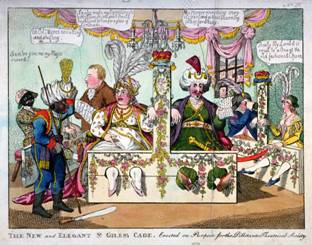 The Pic Nic Society was a fashionable theatrical club founded in London in 1802, which attracted various decadent aristocrats....and also the attention of satirists.
The man and the woman sitting in the ornate stocks in the centre are Colonel Greville and Lady Buckinghamshire. Yes, its Albinia again (see "Faro's Daughters"
above). The first performance by the Society was a comedy set in Spain under the Moors, hence the Moorish costumes.
The Pic Nic Society was a fashionable theatrical club founded in London in 1802, which attracted various decadent aristocrats....and also the attention of satirists.
The man and the woman sitting in the ornate stocks in the centre are Colonel Greville and Lady Buckinghamshire. Yes, its Albinia again (see "Faro's Daughters"
above). The first performance by the Society was a comedy set in Spain under the Moors, hence the Moorish costumes.
As players at an unlicensed theatre
these amateur actors colud potentially be threatened with vagrancy proceedings, which is why the satirist has depicted them in the stocks: "The new and elegant
St Giles cage. Erected on purpose for the dillitanti theatrical society." (1802) by Charles Williams.
Fenians
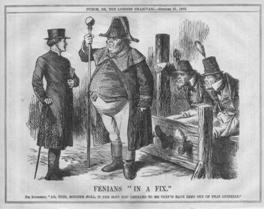 A forerunner to the IRA, the Fenians strove for the establishment of an independent Irish Republic in
the 19th and early 20th centuries. They were either freedom fighters or terrorists, depending on your point of view.
A forerunner to the IRA, the Fenians strove for the establishment of an independent Irish Republic in
the 19th and early 20th centuries. They were either freedom fighters or terrorists, depending on your point of view.
This cartoon was published in Punch (a British magazine) on 21 October 1865. At that time, the Fenian movement was relatively new and was
merely agitating for political change. In the cartoon the Fenians are being discussed in patronising tones by a bishop and a John Bull-like
beadle, both recognisable establishment figures. The Fenians in the stocks are portrayed as uncouth savages, tapping in to British prejudice
towards the Irish at that time.
The British government began to take the Fenians far more seriously following an armed uprising in 1867. When that failed, the Fenians began
a terrorist campaign of bombings and political assassinations. Following the establishment of an independent Irish Republic in 1922, this
terrorist campaign continued sporadically throughout the 20th century. The aim was to achieve independence for Northern Ireland, which remained
under British rule.
|
A Dream of the Pillory
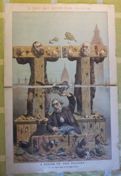 Following from "Fenians" (above), this cartoon satirises the political proponents of Irish home rule. I am uncertain who the other two figures are, but William Gladstone (a British Prime Minister) occupies the right hand pillory.
Following from "Fenians" (above), this cartoon satirises the political proponents of Irish home rule. I am uncertain who the other two figures are, but William Gladstone (a British Prime Minister) occupies the right hand pillory.
This cartoon was published on 26 March 1887 in a weekly magazine called "St Stephen's Review". The cartoonist signed himself as Tom Merry, whose real name was William Mecham.
|
Beware the Coalition
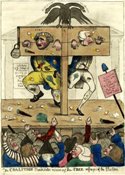 Charles James Fox and Lord Hood (both leading politicians in the late 18th century) shown in a pillory in Covent Garden, London. The mob is pelting them with eggs and vegetables for their perceived attempt to rig the General Election.
Charles James Fox and Lord Hood (both leading politicians in the late 18th century) shown in a pillory in Covent Garden, London. The mob is pelting them with eggs and vegetables for their perceived attempt to rig the General Election.
The text on the picture reads: "The Coalition Candidates receiving the free suffrages of the Electors". The padlock on the pillory is inscribed with "1790 Freedom of Election".
This cartoon was published in June 1790. The artist is William Dent.
|
Quack doctors
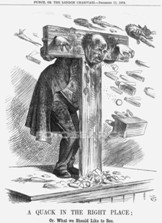 In previous centuries, it would have been difficult to distinguish between a genuine doctor and a quack
doctor, as the level of medical knowledge was generally abysmal. Many people would entrust their care to a village “wise woman”, rather than
turn to the medical practitioner. Doctors were expensive, and their remedies were as likely to kill as cure.
In previous centuries, it would have been difficult to distinguish between a genuine doctor and a quack
doctor, as the level of medical knowledge was generally abysmal. Many people would entrust their care to a village “wise woman”, rather than
turn to the medical practitioner. Doctors were expensive, and their remedies were as likely to kill as cure.
Things started to improve in the 19th century and, in 1858, the UK Parliament passed the Medical Act which provided for a register of qualified
doctors. The Act also attempted to regulate the unqualified and unscrupulous “quacks” who often promoted their dubious cures on the streets, or
in newspapers and magazines.
The threat of prosecution did little to deter the sale of unlicensed patent medicines (then and now), and the gullible continued to be taken in
by extravagant claims to cure almost everything. At best these medicines were harmless placebos; at worst they were actively poisonous. It was
not unknown for some of these cures to contain lead, arsenic and other proven toxins.
This cartoon was published on 17 December 1864, and depicts a quack doctor in the pillory. In addition to the traditional vegetables and dead
cats, the quack is also being pelted with his own dubious medicines.
|
Dreyfus
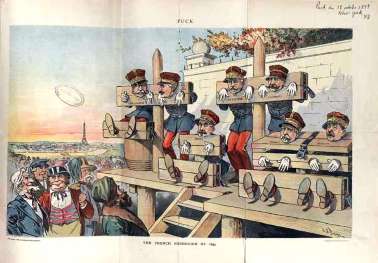
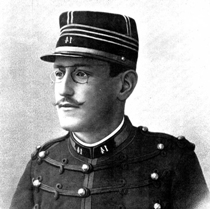 The Dreyfus affair was a political scandal that divided France from its inception in 1894 until its resolution
in 1906. It involved the conviction for treason in November 1894 of Captain Alfred Dreyfus (pictured), a young French artillery officer of Alsatian Jewish
descent. Sentenced to life imprisonment for allegedly having communicated French military secrets to the German Embassy in Paris, Dreyfus was
sent to the penal colony at Devil's Island in French Guiana, where he spent almost five years.
The Dreyfus affair was a political scandal that divided France from its inception in 1894 until its resolution
in 1906. It involved the conviction for treason in November 1894 of Captain Alfred Dreyfus (pictured), a young French artillery officer of Alsatian Jewish
descent. Sentenced to life imprisonment for allegedly having communicated French military secrets to the German Embassy in Paris, Dreyfus was
sent to the penal colony at Devil's Island in French Guiana, where he spent almost five years.
Two years later, in 1896, evidence came to light identifying a French Army major named Ferdinand Walsin Esterhazy as the real culprit. After
high-ranking military officials suppressed the new evidence, a military court unanimously acquitted Esterhazy after the second day of his trial.
The Army accused Dreyfus of additional charges based on false documents. Word of the military court's framing of Dreyfus and of an attendant
cover-up began to spread, chiefly owing to “J’accuse”, a vehement open letter published in a Paris newspaper in January 1898 by the notable
writer Émile Zola. Progressive activists put pressure on the government to reopen the case.
In this cartoon, the French generals who had attempted to frame Dreyfus (ostensibly for anti-semitic reasons) are in stocks and pillories,
exposed to international condemnation. Their disgrace is being viewed by characters representing all the nations of the world, with Uncle Sam
and John Bull prominently in the foreground.
In 1899, Dreyfus was brought to France for another trial. The intense political and judicial scandal that ensued divided French society between
those who supported Dreyfus those who condemned him. The new trial resulted in another conviction and a 10-year sentence, but Dreyfus was given
a pardon and set free.
Eventually, all the accusations against Alfred Dreyfus were demonstrated to be baseless. In 1906, Dreyfus was exonerated and reinstated as a
major in the French Army. He served during the whole of World War I, ending his service with the rank of Lieutenant-Colonel.
|
Napoleon Bonaparte
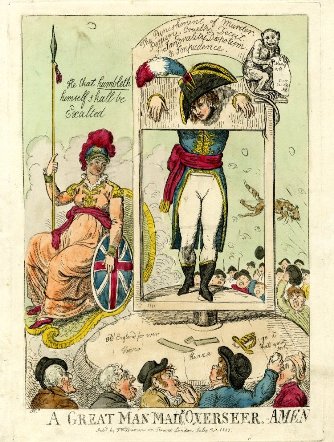 The French emperor, Napoleon Bonaparte, is portrayed in the pillory being pelted by an English crowd. Beside him sits Britannia on a throne, representing England. Above the pillory is a sign detailing Napoleon's alleged crimes: "The punishment of murder, perjury, cruelty, deceit, immorality, despotism and impudence".
The French emperor, Napoleon Bonaparte, is portrayed in the pillory being pelted by an English crowd. Beside him sits Britannia on a throne, representing England. Above the pillory is a sign detailing Napoleon's alleged crimes: "The punishment of murder, perjury, cruelty, deceit, immorality, despotism and impudence".
A monkey sits on top of the pillory, which could allude to a popular legend. The story goes that during the Napoleonic Wars, a French ship was wrecked off Hartlepool, a fishing village on the north-east coast of England. The only survivor was the ship's mascot, a monkey which was washed ashore.
The people of Hartlepool had never seen a monkey before - nor had they ever set eyes on a Frenchman. Mistaking its chattering for the language of the enemy, they convicted the monkey of being a French spy and hanged the animal on the beach. Even to this day, people from Hartlepool are sometimes referred to as "monkey hangers".
A hand-coloured etching, dated 20 July 1803. Napoleon was First Consul of the French Republic at that time, but had himself proclaimed Emperor the following year.
|
In the Interest of Labor and Morality
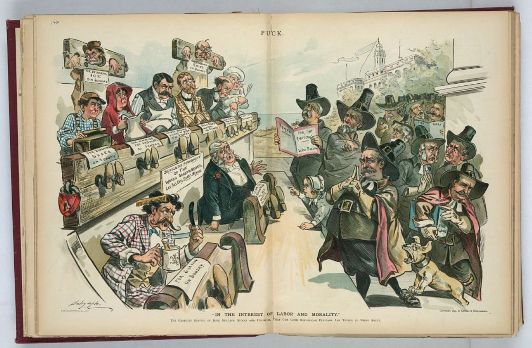 This is an illustration by Louis Dalrymple which was published in "Puck" magazine on 16 October 1895. It ridicules the puritanical approach taken by
the authorities at the time, particularly in regard to trading on Sundays.
This is an illustration by Louis Dalrymple which was published in "Puck" magazine on 16 October 1895. It ridicules the puritanical approach taken by
the authorities at the time, particularly in regard to trading on Sundays.
The picture shows, on the left, many businessmen and women in stocks and pillories for such offences as "serving guests wine on Sunday", "for shaving on
Sunday", "for delivering ice on Sunday", "for selling a glass of beer on Sunday", "for blacking shoes on Sunday", and "for working the growler on Sunday";
a notice states "Behold the Punishment of the Wicked Sabbath Breaker. Let All Evil Doers Beware".
On the right is a group of New York legislators dressed as puritans, including Lieut. Governor Charles T. "Saxton", Thomas C. "Platt", Jacob M. "Patterson",
Hamilton "Fish", Frederick S. "Gibbs", Warner "Miller", Governor Levi P. "Morton", Chauncey M. "Depew" and Jacob S. "Fassett".
The caption underneath the drawing says: "The glorious revival of blue Sundays, stocks and pillories, that our good Republican Puritans are trying to bring about".
Citation: Bos, Carole "To the Pillory "In the Interest of Labor and Morality"" AwesomeStories.com. Mar 16, 2016.
|
Ye Scolds
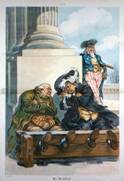 An illustration by Udo Keppler published in "Puck" magazine on 3 February 1909. A heavyset man depicting Congress and Theodore Roosevelt, both in colonial dress, sit beside each
other, locked in a stockade at the ankles. Congress, with arms folded, looks angrily at Roosevelt who, with arms folded, thumbs his nose at his adversary. Their
backs are against the base of a column beside which stands Uncle Sam in a three-cornered hat, who guards them with a billy club.
An illustration by Udo Keppler published in "Puck" magazine on 3 February 1909. A heavyset man depicting Congress and Theodore Roosevelt, both in colonial dress, sit beside each
other, locked in a stockade at the ankles. Congress, with arms folded, looks angrily at Roosevelt who, with arms folded, thumbs his nose at his adversary. Their
backs are against the base of a column beside which stands Uncle Sam in a three-cornered hat, who guards them with a billy club.
|
Other satirical American cartoons
Unfortunately I have no information on the following American cartoons. If anyone can shed some light on either of these, I would be most grateful.
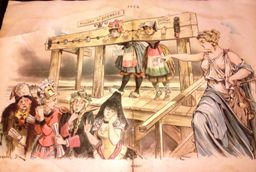
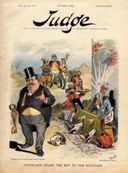
|
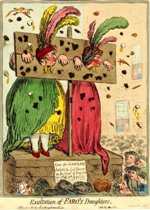
 Albinia, Countess of Buckinghamshire (pictured), was notorious for her gambling parties in the late 18th and
early 19th centuries. She was particularly fond of faro, an illegal gambling game. Albinia and her aristocratic lady friends were often
attacked in satirical prints because of their gambling and decadent lifestyles.
Albinia, Countess of Buckinghamshire (pictured), was notorious for her gambling parties in the late 18th and
early 19th centuries. She was particularly fond of faro, an illegal gambling game. Albinia and her aristocratic lady friends were often
attacked in satirical prints because of their gambling and decadent lifestyles. x.jpg)
x.jpg)
x.jpg)
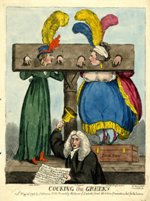











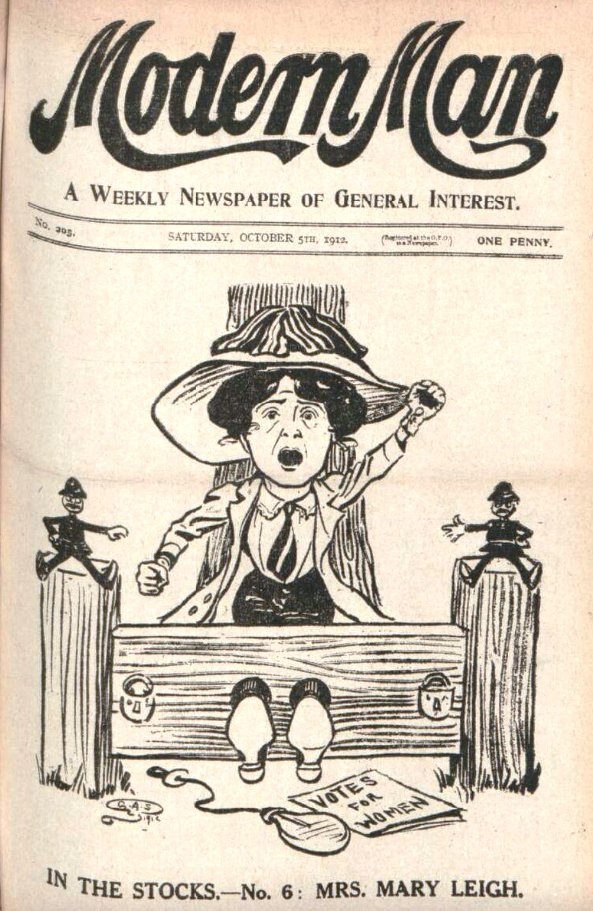
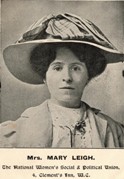
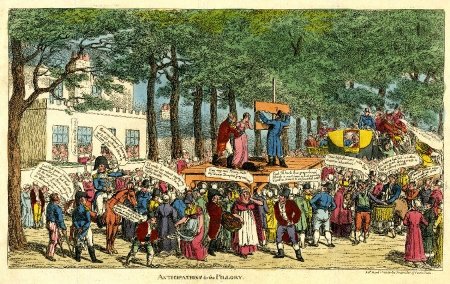
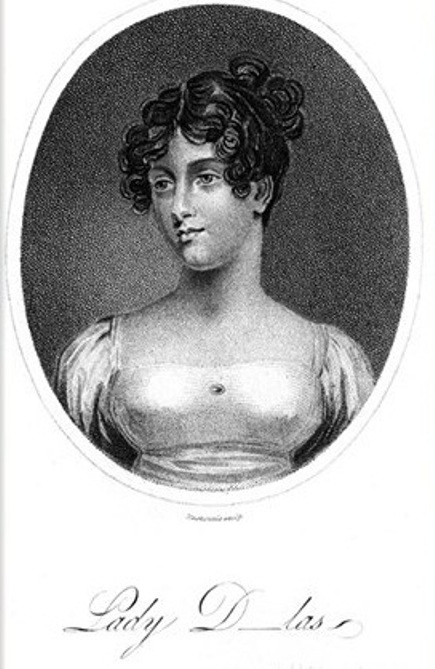
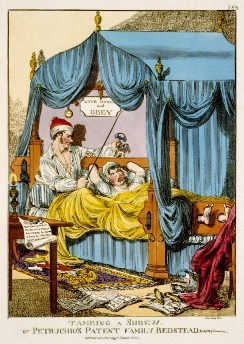
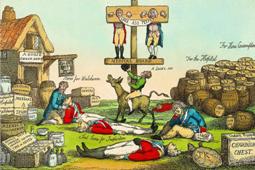
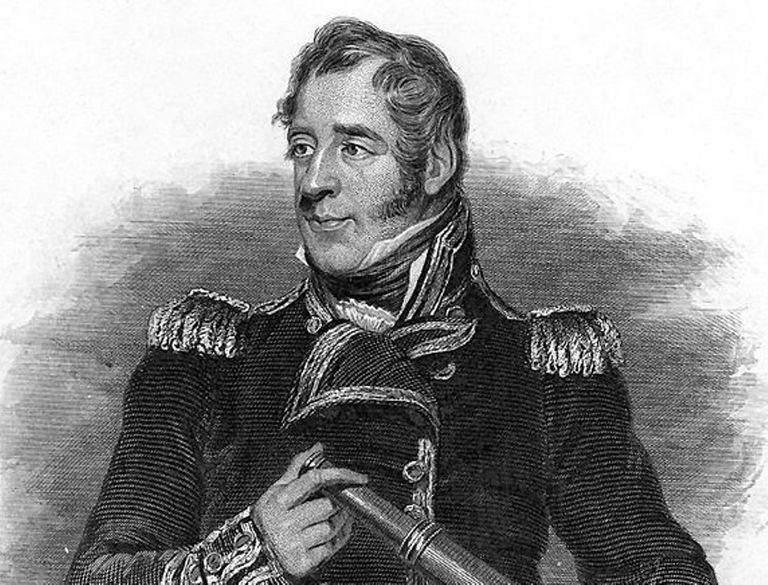 Thomas Cochrane, 10th Earl of Dundonald, was one of Britain's greatest naval heroes. Cochrane was the inspiration for the eponymous hero of the Horatio Hornblower books and television series. He was also the basis for the Captain Jack Aubrey books, on which the film "Master and Commander: The Far Side of the World" was based.
Thomas Cochrane, 10th Earl of Dundonald, was one of Britain's greatest naval heroes. Cochrane was the inspiration for the eponymous hero of the Horatio Hornblower books and television series. He was also the basis for the Captain Jack Aubrey books, on which the film "Master and Commander: The Far Side of the World" was based.
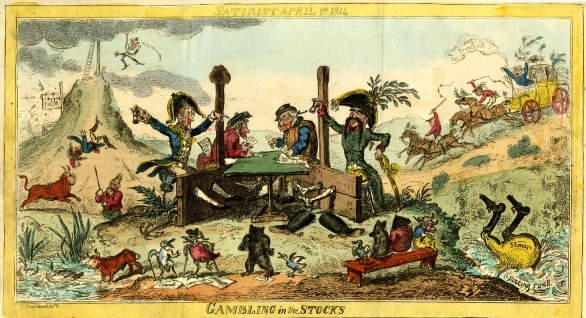
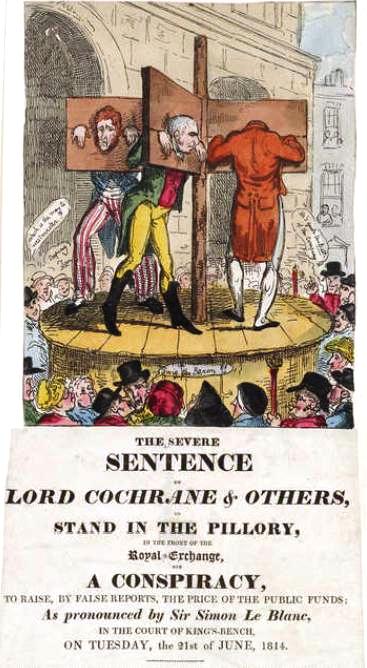 The cartoon on the left satirises Cochrane and his alleged accomplices in the fraud. However there was a subsequent public outcry against the Cochrane' sentence, particularly the pillory part. The cartoon on the right satirises the establishment, not Cochrane. Even Napoleon Bonaparte came to Cochrane’s defense. “Such a man should not be made to suffer so degrading a punishment,” he said at the time. The standing in the pillory was remitted, perhaps because Sir Francis Burdett, a fellow MP, proclaimed his intention of standing with Cochrane, but more likely because the government feared a riot.
The cartoon on the left satirises Cochrane and his alleged accomplices in the fraud. However there was a subsequent public outcry against the Cochrane' sentence, particularly the pillory part. The cartoon on the right satirises the establishment, not Cochrane. Even Napoleon Bonaparte came to Cochrane’s defense. “Such a man should not be made to suffer so degrading a punishment,” he said at the time. The standing in the pillory was remitted, perhaps because Sir Francis Burdett, a fellow MP, proclaimed his intention of standing with Cochrane, but more likely because the government feared a riot.
